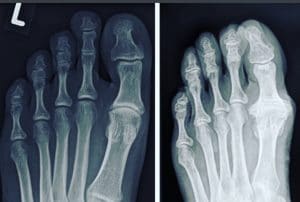Hallux Rigidus translates into arthrosis of the big toe (joint degeneration), which ultimately results in its painful stiffening. If this happens, every step causes pain. In an advanced stage, this pain even remains in periods of rest, especially during the night.
Hallux Rigidus: What Causes the Pain?
The painful Hallux Rigidus arises because the protective layer of cartilage within the joint wears out gradually. As a consequence, the underlying bones rub against each other and cause painful symptoms. In addition to that, the big toe may develop boney bumps that make it difficult to fit into shoes.
Hallux Rigidus: How does the arthrosis develop?
The following X-ray image shows an image of a Hallux Rigidus patient and, for comparison, normal findings.

Various reasons may emerge in the arthrosis of the big toe.
Rheumatic disease
Patients with rheumatism might suffer from polyarthritis, involving several joints of the body. The big toe could be part of that. Rheumatism (rheumatoid arthritis) causes the body’s own defence mechanisms to turn against the joints and destroy them. In the case of Hallux Rigidus, a rheumatic disease should be taken into consideration.
Gout (elevated uric acid in the blood, so-called. Hyperuricemia)
As a result of a gout disease, crystals are deposited in the joints. This compares to grains of sand in a gear wheel and eventually destroy the joint, thus arthrosis. In the diagnostic procedure, the physician needs to clarify if the Hallux Rigidus is the result of such a process.
Foot deformities such as Hallux valgus
In the case of chronic misalignments such as Hallux valgus (bunion), a hallux Rigidus may occur as a result of this.
Hallux Rigidus Surgery: What Are the Options?
In case conservative treatments such as medical shoe inlays, Rigidusfeder or special dispensing aids do not help and the patient suffers a lot, surgery is a valid option.
The surgical methods can roughly be divided into 2 groups: Joint preserving and joint stiffening approaches.
Joint preserving procedures
Joint preserving procedures can be applied in an early stage of Hallux Rigidus. They include, for example, the so-called joint toilette (the term derives from ’to clean’), including the removal of inflamed joint synovium (synovectomy) and the removal of bone surpluses. Another option is to shorten the metatarsal bone.
Joint stiffening approaches
If the joint of the big toe is already significantly destroyed, it has to be stiffened in order to ease the pain. Some patients misconceive term stiffening as something that would affect their mobility. This is not the case Even though the joint itself loses flexibility, the overall mobility is hardly compromised, also in case of an athletic career. After the surgery, a regular training schedule can be resumed.
The stiffening surgery is performed by implanting screws and/or a plate into the joint.
Hallux Rigidus Surgery: What Happens after the Surgery?
- Removal of stitches after about 2 weeks
- Wearing a special shoe for about 2- 6 weeks, depending on the surgical method
- Possibly manual lymph drainage depending on swelling
Hallux Rigidus Surgery: Conclusion
Osteoarthritis-related pain and discomfort can be most effectively removed by surgical procedures. Afterwards, patients will be able to walk again without pain.
Hallux Rigidus Surgery Germany: Consult Foot Specialist Adem Erdogan

Do you have questions about the treatment, the risks or the costs concerning the Hallux Rigidus surgery?
After a consultation and detailed examination, Adem Erdogan creates a treatment plan tailored to the individual needs of the patients for ideal results. He will be happy to answer all of your questions.
Make your initial appointment now!

